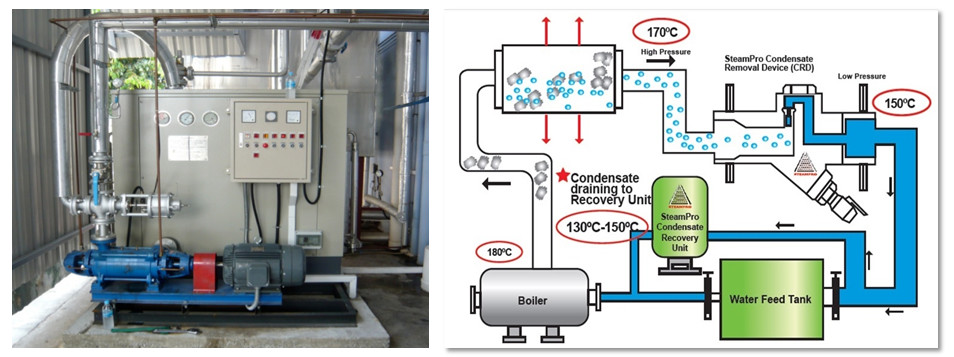|
Steampro-Condensate Recovery Unit (SP-CRU)
SP-CRU has been designed to operate efficiently at high pressures and temperatures. The SP-CRU high pressure in the condensate return system reduces flash steam.
The SP-CRU is a closed vessel system that collect condensate from steam line and pump much higher condensate temperature back to the boiler directly so that the boilers doníŽt have to work as hard, thus saving fuel. SP-CRU recovers condensate at a much higher temperature condensate than the usual pump in the market.

HOW SP-CRU SAVES?
EXAMPLE OF HOW PATENTED STEAMPRO HIGH- PRESSURE- CONDENSATE- RECOVERY SAVES
Assuming boilers running at 10 ~ 11 bars steam pressure and returning the condensate at 0 bars. Condensate at a pressure of 0 bar returns to the boiler at 100oC or lower. We may want to return the condensate at higher pressures to reduce the energy consumption.
Let us return the condensate to the boiler at, say, 4 bars. Your operating equipment will have a good pressure differential of 10 – 4 = 6 bars. Some of the equipment may need to use a lower steam pressure near or below 4 bars; the condensate from this equipment will need to be rerouted or not recovered.
Example Savings 1: From Condensate Returned at Higher Temperature
At a return pressure of 4 bars, the temperature of the condensate is 152oC and it carries an energy of 640 KJ/kg compare to condensate at atmospheric of 100oC and 418 KJ/kg. If we conservatively assumed that 80% of the condensate maybe recovered due to losses and boiler blow down. The total energy for a kilogram of steam is 2,678 KJ/kg from water equal to 25oC. Therefore, the saving is (640 – 418) / 2678 x 0.80 = 0.066 or 6.6%.
Example Savings 2: From Reduction of Flash Steam
Recovering the condensate at a pressure of 4 bars instead of 0 bars will also reduce the formation of flash steam. Steam cannot be returned to the boiler. Both the energy and the water in the flash steam will be a total loss to the atmosphere. The flash steam rate from a steam pressure of 10 bars maybe calculated as follows:
- At 0 bars condensate return pressure, (781 – 418) / 2258 x 100 = 16.1%
- At 4 bars condensate return pressure, (781 – 640) / 2109 x 100 = 6.7%
This is a saving of 9.4% of the total energy. Assuming that 10% of the condensate is not recovered or lost, the total saving is 9.4 x 0.90 = 8.5%.
The total energy saving of a high pressure condensate recovery system is 8.5 + 6.6 = 15.1%. The total energy saving is larger for increased condensate return pressure. Setting a condensate recovery pressure of 4 bars will provide you with handsome energy saving and ensure a good useful life expectancy of the high pressure condensate return pump(s).
Example Savings 3: From Lesser Water and Water Treatment Chemicals
Your boiler makeup (feed) water is reduced by 8.5%, a recovery of your flash steam. You will have saving in water and boiler water treatment chemicals. Because of the reduction in boiler makeup water, your need for boiler blow down is also reduced. We have not included the aforementioned savings in our calculations.
The calculated saving of 15.1% (6.6% of Savings 1 and 8.5% of Savings 2 only) is conservative. A conservative 15.1% savings will be achieved if install our Patented SteamPro High Pressure Condensate Recovery Unit and slightly modified part of your condensate recovery system.
Written By:
Dr Michael Troy
(On November 2005 at Kuala Lumpur, Malaysia)
Note:
This write-up shall be used with the permission of SteamPro Conservation Sdn Bhd and is not meant for public usage or circulation.
|


